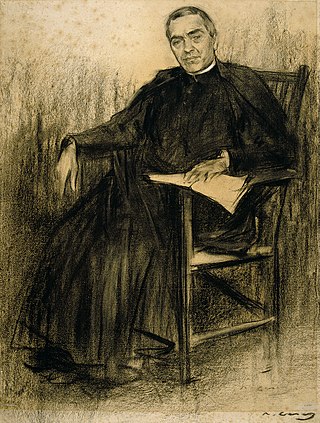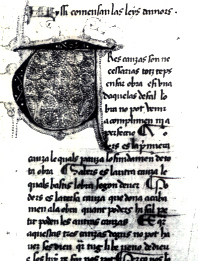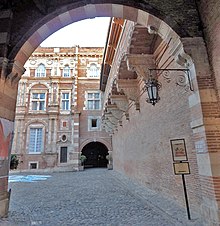
Jacint Verdaguer i Santaló was a Catalan writer, regarded as one of the greatest poets of Catalan literature and a prominent literary figure of the Renaixença, a cultural revival movement of the late Romantic era. The bishop Josep Torras i Bages, one of the main figures of Catalan nationalism, called him the "Prince of Catalan poets". He was also known as mossèn (Father) Cinto Verdaguer, because of his career as a priest, and informally also simply "mossèn Cinto".

Catalan literature is the name conventionally used to refer to literature written in the Catalan language. The focus of this article is not just the literature of Catalonia, but literature written in Catalan from anywhere, so that it includes writers from Andorra, the Valencian Community, Balearic Islands and other territories where any Catalan variant is spoken.

The Consistori del Gay Saber was a poetic academy founded at Toulouse in 1323 to revive and perpetuate the lyric poetry of the troubadours.
The Consistoride Barcelona was a literary academy founded in Barcelona by John the Hunter, King of Aragon and Count of Barcelona, in 1393 in imitation of the Consistori del Gay Saber founded in Toulouse in 1323. The poetry produced by and for the Consistori was heavily influenced by the troubadours. The Consistori's chief purpose was to promote "correct" styles and themes and discourage vices (vicis) by awarding prizes in competition to poets who adhered to the "rules" of poetic composition. The names of few poets laureate have come down to us and despite some excellent descriptions of the Consistori's activities, associated persons and poems are obscure.
Arnaut Vidal de Castelnou d'Ari was a medieval Occitan author from Castelnaudary.
Lorenç Mallol was a Catalan poet of the fourteenth century, the first Petrarchan of his country and one of the last troubadours. His two surviving pieces are composed in Old Occitan. His first name is also spelled Laurenç in modern Occitan and Llorenç in modern Catalan.

Gilabert de Próixita was a Valencian poet with twenty-one extant Occitan pieces. He is credited by his first editor with a renovellament (renewal) of Catalan poetry through the incorporation of Italian and French ideas into a model of courtly love taken from the classical troubadours. His last name is variously spelled Próxita, Próxida, and Progita in medieval orthography.

Joan Margarit i Consarnau was a Catalan poet, architect and professor. Most of his work is written in the Catalan language. He won the 2019 Miguel de Cervantes Prize.
Guillem de Masdovelles was a Catalan soldier, courtier, politician, and poet. His family came from the Penedès, but he was active in Barcelona, where he became a civic leader. His fifteen poems are preserved alongside the work of his nephew, Joan Berenguer, in a chansonnier compiled by Joan around 1470, the Cançoner dels Masdovelles. Guillem exchanged some poetry with his nephew, who also translated some of Guillem's Occitan pieces into the Catalan language. Guillem also participated in at least three public poetry contests.

A maldit was a genre of Catalan and Occitan literature practiced by the later troubadours. It was a song complaining about a lady's behaviour and character. A related genre, the comiat, was a song renouncing a lover. The maldit and the comiat were often connected as a maldit-comiat and they could be used to attack and renounce a figure other than a lady or a lover, like a commanding officer. The maldit-comiat is especially associated with the Catalan troubadours. Martí de Riquer describes un autèntic maldit-comiat as a song where a poet leaves a mistress to whom he has long been fruitlessly devoted, and explains her failings which have led him to depart.
Bernat de Palaol or de Mallorques was a Catalan troubadour and merchant from Majorca. He was sometimes called lo mercader mallorquí.
Germà de Gontaut was an Occitan poet and merchant.
Luys Ycart, or Lluís Icart in modern orthography, was a Catalan poet. He left behind fourteen lyric poems and a long poem called Consolació i Avís d'amor. All of his poetry was produced before the composition of the chansonnier Vega-Aguiló (1420–30), into which it was copied soon after it was written.
Johan Blanch was an Occitan troubadour who composed a canso for a joc floral at the Consistori del Gay Saber. According to the rubric of the fourteenth-century chansonnier that preserves it, he was a Catalan whose poem "won the violet", top prize. His canso is elegant and pleading.
Jacme Scrivà was a Catalan knight and poet of the late fourteenth century. In contemporary documents Jacme's name is spelled Jacme Scriva, without the accent. In modern Catalan orthography it is spelled Jaume Escrivà. His surname means "scribe".
Luys d'Averçó or Luis de Aversó (c.1350–1412x15) was a Catalan politician, naval financier, and man of letters. His magnum opus, the Torcimany, is one of the most important medieval Catalan-language grammars to modern historians. His name is spelled Lluís d'Averçó or d'Aversó in modern orthography.
Anna Aguilar-Amat is a Catalan poet, translator, researcher and university professor in Terminology and Computational Linguistics. She writes primarily in Catalan but also has some work in Spanish. She has a PHD from the Universitat Autònoma de Barcelona where she now teaches Terminology applied to Translation at the Translation Faculty. She published five collections of poems and has received several awards for Catalan poetry. Her poetic work is present in several anthologies of Catalan poets and she has been translated into Spanish, English, French, Italian, Sardinian, Macedonian, Finnish, Arabian, Turkish, Greek, German and Slovenian. She was included in the Anthology New European Poets by Wayne Miller & Kevin Prufer, Minnesota 2008.
Albert Guillem Hauf i Valls is a Majorcan philologist, literature historian and literary critic. He is a specialist in Catalan and Occitan medieval literature.

Caterina Albert i Paradís, better known by her pen name Víctor Català, was a Catalan writer in Catalan and Spanish who participated in the Modernisme movement and was the author of one of the signature works of the genre, Solitud (Solitude) (1905). Her literary skill was first recognized in 1898, when she received the Jocs Florals prize; soon thereafter, she began using the pseudonym Victor Català, taking it from the protagonist of a novel she never finished. Despite her success as a dramatist and her forays into poetry, she is best known for her work in narrative literature, with the force of her style and the richness of her diction being especially noted. She died in her hometown of l’Escala, Catalonia, in 1966 and is interred in the Cementiri Vell de l’Escala.
Two institutions grant the Fastenrath Awards: Fundación Premio Fastenrath awards writers of Spanish nationality and their Spanish works and Premi Fastenrath for Catalan works. Both were instituted with the posthumous legacy of Johannes Fastenrath Hürxthal.









